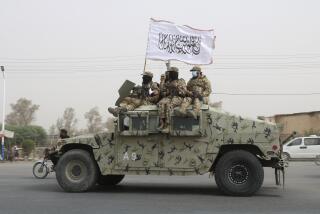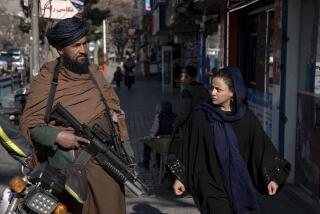Failed Coup Deepens Scars on Afghan Capital, Leaders
- Share via
KABUL, Afghanistan — President Najibullah had just started his scheduled meeting with a group of tribal commanders from Balaran province at 1:10 p.m. last Tuesday when he and his Soviet-backed government came literally within feet of oblivion.
An Afghan air force MIG-21 fighter with a renegade pilot at the controls screeched down on Najibullah’s sprawling palace complex and dropped three bombs with near-precision, thus launching the bloody two-day coup d’etat that came closer to succeeding than the outside world knew.
The bombs rocked the palace, shattering every window and leaving craters as deep as water wells just outside the 43-year-old president’s private office. But Najibullah escaped unharmed.
On Friday, the craters and cracked walls were mute reminders of the damage that the failed coup has wrought on Afghanistan’s already war-torn capital, as well as on Najibullah’s embattled government.
“You can see for yourselves now what they have done,” a lieutenant colonel in the palace guard declared, as he escorted the first Western journalists to arrive in Kabul since the Afghan military uprising was crushed.
Indeed, throughout the capital, thousands of windows were smashed by the initial blasts and powerful shock waves of at least 18 half-ton bombs that diplomats here estimate were dropped largely on government and military installations. Scores of houses in the firing line are pockmarked by shrapnel.
Several embassies were damaged, including those of Italy, China, India and Iran. Every window was blown out in the U.S. Embassy, which has been vacant since American diplomats pulled out during the final phase of the Soviet troop withdrawal a year ago; otherwise the embassy buildings appeared intact.
The government said Friday that at least 25 civilians were killed and 150 others were wounded in the fighting. Independent diplomatic observers said the civilian death toll probably was closer to 100.
No military casualty figures have been released, but judging from the extensive damage in the Defense Ministry complex, which served as headquarters during the coup for the revolt’s leader, Defense Minister Shahnawaz Tanai, the death toll among soldiers is likely to be much higher.
There are rocket holes and tank-shell blasts in much of the once-spectacular Darulaman Palace complex, which houses the ministry. Tanai’s private, third-floor office now bears a gaping tank-shell hole just above the window. Parts of the roof were flattened by the loyalist troops’ artillery and tank assault. Yet some of the crystal chandeliers and oil paintings in the building came through unscathed.
Virtually every other building in the mile-square complex, which also was opened for the first time to the half-dozen foreign journalists here Friday, sustained heavy damage, indicating that the rebels had put up a fierce fight.
Government spokesman Naqib Sameer said Friday that several rebel generals and many soldiers who joined Tanai had been arrested and are now being tried by a secret tribunal that convened Thursday.
Speaking to reporters here Thursday, Najibullah had tried to put the coup attempt in the best possible light. He confirmed that Tanai and his supporters were hard-liners within the ruling People’s Democratic Party of Afghanistan who opposed his Moscow-backed policy of negotiating regional settlements with dozens of the moujahedeen rebel commanders who have waged a decade-long holy war against his regime.
The coup plotters, Najibullah said, were obstacles to that policy of national reconciliation, and now those obstacles are gone. But even he conceded that the two-day coup very nearly succeeded and he indicated that his ruling party may well be as heavily scarred in its aftermath as his palace grounds.
During the first three hours of the coup, after six half-ton concussion bombs slammed into his palace and the barracks of his presidential guard, Tanai’s forces had the advantage, Najibullah admitted.
“Between 1 p.m. and 4 p.m., the air force was with Tanai,” he told the reporters. “But the balance shifted after that.”
Several of the pilots involved in what diplomats estimate at as many as 38 bombing sorties refused to drop their payloads, instead landing at provincial air bases and surrendering to Najibullah loyalists. Then, the president said, loyal artillery units attacked Tanai’s headquarters.
When the regime’s forces learned that Tanai had fled to Bagram Air Base, the country’s largest and most strategically located air force base, Najibullah ordered loyalist pilots to bomb it. The base, 30 miles north of Kabul, was left with its runway badly scarred and several buildings destroyed.
Although Najibullah asserted that his regime is again firmly in control of all military facilities and key cities--indeed, the streets of Kabul were unusually peaceful Friday--all is not well within his ruling party. The president announced that he had expelled nearly half of the party’s Politburo members and half of his Supreme Defense Council.
In all, the purge claimed five of the 12 members in each. In addition to Tanai, Najibullah threw out his air force commander, Gen. Gul Aka, as well as another top general, Nazar Mohammed. Both reportedly fled to neighboring Pakistan, along with Tanai.
Pakistani officials continued to insist Friday that Tanai is still inside Afghanistan. They also denied charges broadcast by Radio Kabul that Pakistan had fomented the revolt.
Also expelled from the Politburo was the Afghan ambassador to Moscow, Sayed Mohammed Gulabzoi, the leader of the hard-line Khalq party faction that Tanai belongs to, and fellow Khalq, Niaz Mohammed Momand.
“There is no question the party needs a lot of repair work now, and the only question is whether Najib(ullah) has the time to do it,” said one diplomat here. “With more than a third of the Politburo gone, it’s going to take a lot of rebuilding.”
So is Kabul. In a city routinely battered by moujahedeen rocket attacks, few residents seemed perplexed by the gaping bomb craters in the main downtown squares and intersections. They simply stepped around them as they made their way to market and to Friday prayers at Kabul’s Grand Mosque.
Foreign observers here say the deeper damage is psychological.
“There’s just this deep feeling of insecurity--like waiting for the other shoe to drop,” said one.
Each time a jet fighter passed overhead on routine patrol, for example, every head on the street turned skyward. Some people winced. Others froze. Still others quickly glanced around, searching for cover.
More to Read
Sign up for Essential California
The most important California stories and recommendations in your inbox every morning.
You may occasionally receive promotional content from the Los Angeles Times.










